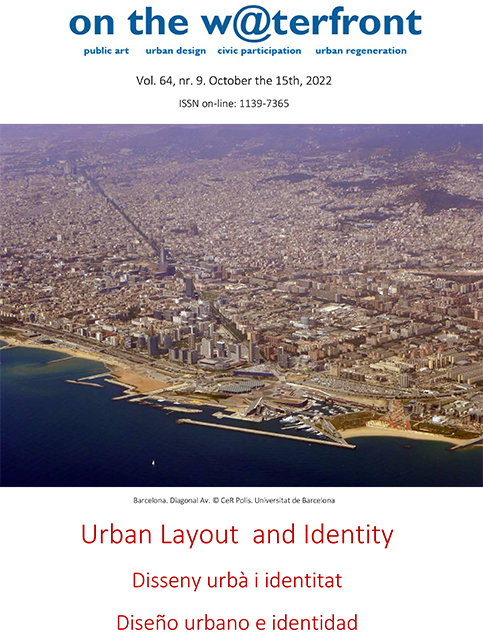(Re) construction of historical memory: identity and urban re-valuation of the first Diagonal in Chile
DOI:
https://doi.org/10.1344/waterfront2022.64.9.01Keywords:
Public Space, Reconstruction, Memory, Urban Landscape, Urban RegenerationAbstract
In the process of urban regeneration, the re-valuation of public space and the elements that configure it assume the potential in the regeneration process, integrating elements as the basis components in the consolidation of urban dynamics. Also, the contained memory of the city, understood as public inheritance, is a continuous and participatory process in which we construct the sense of belonging and place.
The (re) construction of historical memory of the Avenue Diagonal Pedro Aguirre Cerda, the first diagonal axis of Chile, has partly defined the structure of the landscape of the city of Concepcion, being a container of social, historical, and natural processes that accidentally occurred.
Unfortunate but ideal scenarios have been the successive earthquakes that have made our country a fertile ground for rethinking and materializing ideas. It is, in the post-1939 earthquake, when the reconstruction permitted revolutionary thoughts coming from modern Europe and that were materialized, with a privileged location in both the historical space and in the physical city.
The appearance of this axis, in the apposition of the foundational Damero’s plane, is an innovative project that breaks this historic urban trend, taking into Chile, and more specifically into Concepción, a chance to expound innovative ideas, aimed to change the urban landscape prevailing at that time.
In terms of spatial configuration, this diagonal axis is a superposition of historical layers in their development and materialization that has become a mass of history and that is still in development. In other words, it is dynamic and open, consolidating it periodically as an identity space city landscape, harmoniously uniting both the civic world represented by the square courts with the academics symbolized in the University of Concepción.
It is proposed to unravel and rescue the historical context that adds a value in the configuration and coordination of the various parties in relation to the on-going transformation and constitution of this urban piece and its constant identity re-evaluation in favor of the regeneration processes.
References
ARENDT, H. (1958). The human condition. University of Chicago Press, Chicago, IL.
ARENDT, H. (1997). ¿Qué es política? Barcelona: Ediciones Paidós.
BORJA, J., & MUXI, Z. (2000). El espacio público: ciudad y ciudadanía. (Barcelona): Electa.
DECRETO 494 (2021). Promulga la 15° modificación del plan regulador de la comuna de Concepción https://www.bcn.cl/leychile/navegar?i=1162293
El problema de la reconstrucción (1939, 15 de febrero). El Sur, p. 12.
ESPARZA LOZANO, DANAE, SAMUEL E. PADILLA LLANO, ANTONI REMESAR, and XAVIER SALAS. 2012. “Inclusion and Empowerment in Public Art and Urban Design”. On the W@terfront, no. 24 (November):3-32. https://revistes.ub.edu/index.php/waterfront/article/view/18796.
GUROVICH, A. (1985). “Las articulaciones urbanas”. Revista CA Nº41.
HABERMAS, J. (1999). La inclusión del otro : estudios de teoría política. Barcelona: Paidós.
HALBWACHS, M. (1997). La mémoire collective. Paris: Albin Michel.
JACOBS, A. B. (1993). Great streets. Access Magazine, 1(3), 23-27.
La diagonal universitaria contribuirá a dar a Concepción un realce que no se puede apreciar por el momento. (1940, 14 de septiembre). El Sur, p.8.
MATA, R. TORROJA, A. (2006). El paisaje y la gestión del territorio: criterios paisajísticos en la ordenación del territorio y el urbanismo. Barcelona: Diputació de Barcelona, Xarxa de municipis.
MAHIAS, G. (1986). La diagonal Pedro Aguirre Cerda. Arquitecturas del Sur Nº7. Ediciones UBB, Concepción.
MCCLUSKEY, J. (1979). Road form and townscape. Publication of: Architectural Press Limited.
MONTANER, J. M. (2008). Sistemas arquitectónicos contemporáneos. Barcelona. Gustavo Gili.
OLIVER, C. ZAPATTA, F. (1950). Libro de oro de Concepción. Concepción: Litografía Concepción.
PADILLA LLANO, Samuel E. 2016. “The Reform of the Avenida Diagonal. Success or Failure of a Participatory Process?”. On the W@terfront 46 (July):7-84. https://revistes.ub.edu/index.php/waterfront/article/view/18677.
PADILLA LLANO, S. E. (2020). From the urban project to the participative public space project: A historical approach. MÓDULO ARQUITECTURA CUC, 24(1), 67–82. https://doi.org/10.17981/mod.arq.cuc.24.1.2020.04
PEREZ, L. ESPINOZA, L. (2006). El espacio público de Concepción. Su relación con los planes reguladores (1940-2004). Urbano, vol. 9, núm. 13. 32-43, Universidad del Bío Bío, Chile.
RICOEUR, P. (2004). La memoria, la historia, el olvido. Buenos Aires: Fondo de Cultura Económica.
REMESAR, A., & VERGEL FARO, J. (2020). Acceder a la gestión de lo simbólico. Un derecho ciudadano. on the w@terfront. Public Art.Urban Design.Civic Participation.Urban Regeneration, 62(7), 39–56. https://doi.org/10.1344/waterfront2020.62.6.1
REMESAR, A. (2005). Dois apontamentos sobre o espaço público de Lisboa. Arquitecturas nº 6.
REYES-SCHADE, Emilio, GUTIÉRREZ-TORRES, Katheryn y PADILLA-LLANO Samuel Esteban. 2022. «Imbricación Urbana Del Movimiento: Continuidad, Accesibilidad Y estructuración En El Sistema De Tranvía De Ayacucho, Medellín». on the w@terfront. Public Art.Urban Design.Civic Participation.Urban Regeneration 64 (1):3-29. https://doi.org/10.1344/waterfront2022.64.1.01.
SECRETARIA REGIONAL MINISTERIAL DE VIVIENDA Y URBANISMO (2020). Memoria explicativa. 11º Modificacion Plan Regulador Metropolitano de Concepción https://prmconcepcion.minvu.gob.cl/wp-content/prmc/02MemoriaProyecto_11modPRMC.pdf

Downloads
Published
How to Cite
Issue
Section
License
Copyright (c) 2022 Andrea Fernández-Covarrubias, Emilio Reyes-Schade, Samuel E. Padilla-Llano, Ayman Imam

This work is licensed under a Creative Commons Attribution 4.0 International License.
The
 licence allows: Share — copy and redistribute the material in any medium or format and Adapt — remix, transform, and build upon the material for any purpose, even commercially.The licensor cannot revoke these freedoms as long as you follow the license terms. Author's rights are protected by the ISSN 1139-7365. On the w@terfront has no restrictions respect the copyright by the authors and does allow authors to retain the publishing rights without restrictions.
licence allows: Share — copy and redistribute the material in any medium or format and Adapt — remix, transform, and build upon the material for any purpose, even commercially.The licensor cannot revoke these freedoms as long as you follow the license terms. Author's rights are protected by the ISSN 1139-7365. On the w@terfront has no restrictions respect the copyright by the authors and does allow authors to retain the publishing rights without restrictions.This journal does not apply any type of charge to the authors for the presentation or processing of the articles.






